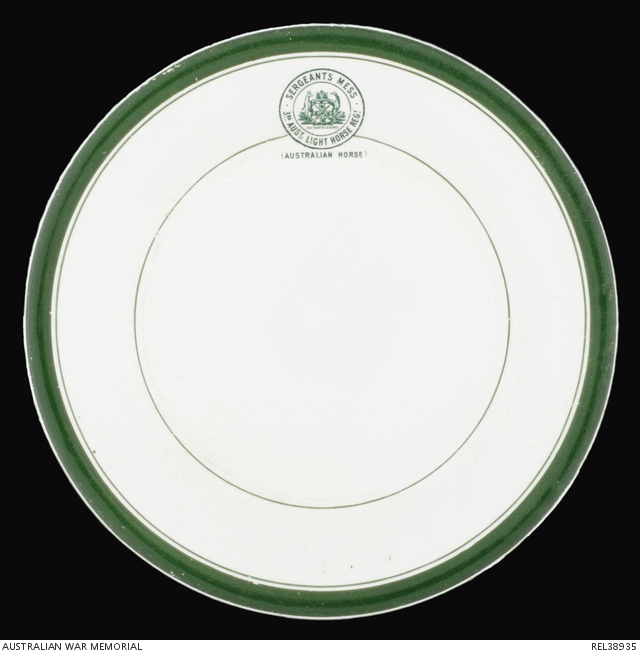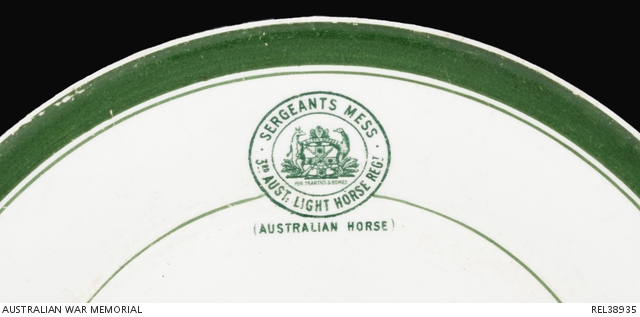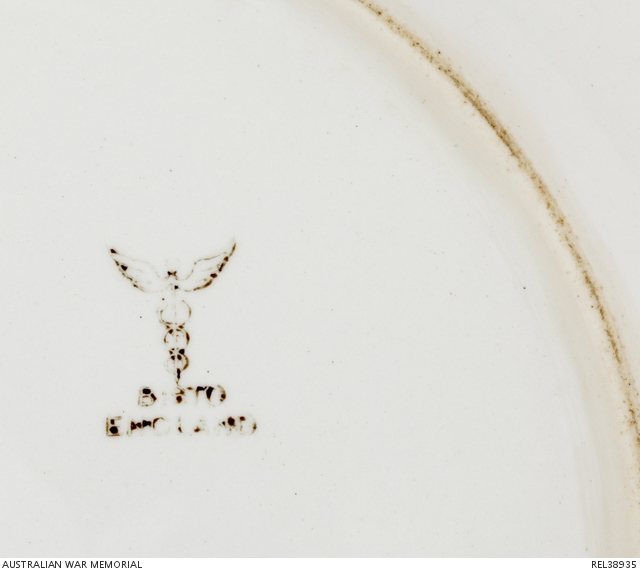| Place | Oceania: Australia, New South Wales, Goulburn |
|---|---|
| Accession Number | REL38935 |
| Collection type | Heraldry |
| Object type | Heraldry |
| Physical description | Pottery |
| Maker |
Bishop and Stonier |
| Place made | United Kingdom: England, Staffordshire |
| Date made | c 1903 |
| Conflict |
Period 1900-1909 Army organisation period 1903-1912 |
Bread and butter plate, Sergeant's Mess, 3 Australian Light Horse Regiment : Sergeant J Williams



White glazed pottery bread and butter dish. The circumference is decorated with one thick and one thin green band with a second thin band around the inner base. The inner wall is decorated with a transfer showing the regimental badge - the NSW coat of arms over the motto 'For Hearths and Homes', bordered with the words 'Sergeants Mess / 3rd Aust Light Horse Regt'. Below are the words 'Australian Horse' in brackets. The base is marked with the maker's name (Bisto) and symbol (a caduceus) in green, a hand painted decorator's or pattern number (E2148) and the initials 'G.W.' in texta.
3rd Australian Light Horse sergeant's mess plate relating to the militia service of Sergeant Jonathan Williams. Born Lake George, NSW in the late 1860s and a drover by occupation, Williams lived in Goulburn, NSW; his brother, Thomas, served in the Deniliquin Police. By his early 20s, Williams had developed a good reputation as a sportsman in the local area, both as a footballer and a boxer. Ransome Wyatt, in his 'History of Goulburn' states (p 458) 'among the late Jonathan Williams' outstanding sporting achievements was his showing in the Rugby Union match which Goulburn played against an English XV on the old showground. Goulburn was defeated by nine points to three and its try was secured by a player named Plimpton after good work by Williams.' He was also notable locally a winning the District Amateur Lightweight Championship, with additional experience in fights in Melbourne. Wyatt adds: 'at the close of the South African War he gained the light welterweight championship of the British Army, defeating Harry Cooper of the Dublin Fusiliers after 13 rounds'. Williams had previously served in South Africa for 15 months as a Lance Corporal, with the service number 984, with the NSW Imperial Bushmen. An unmarried resident of Grafton St, Goulburn, Williams was 31 years when he joined up for his second tour, with 5 Battalion, Australian Commonwealth Horse. He arrived in Durban, South Africa aboard the 'Columbian' on 18 June 1902, just as the war ended, and he and his unit were obliged to return to Australia without seeing service. They aboard the 'Manchester Merchant'. This plate is associated William's later service in the militia. The badge and myrtle green banding on the plate reflects the fact that 3 Australian Light Horse was part of the Australian Horse, raised in 1897, whose original uniform was this distinctive green.